This post may contain affiliate links. If you use these links to buy something we may earn a commission. Thanks.
The best thing about planting a fruit tree in a tolerable shady place is you’ll get fruit, but not end up with too much fruit to handle!
Fruit and shade mix well in zone 9 because you get to dip into both cold-climate fruits and tropical fruits! Both climates offer various trees that grow and produce fruit in the shade.
But the last thing you want is a fruit tree in the shade that grows but doesn’t fruit.
So I handpicked the tree options in this post to ensure that you’ll get fruit from all trees of choice! All the best fruit trees for partial shade have anecdotally proven to produce food even in shadier than sunny situations.
Quince, mulberry, peach, pear, loquat, fig, guava, Tahitian lime, and Meyers lemon are the best semi-shade fruit-producing trees for zone 9. Many growers around the world have reported that these trees, in a shaded situation, are producing good fruit.
In general, most fruit trees produce the best fruit in sunny positions, but local gardeners, horticultural or agricultural societies, and extension offices can provide insights into the regional performance of each tree. Including, the best varieties for your placement.
I’ve visited USDA Zone 9 for extended periods numerous times and have gathered insights from growers, and learned about the plants by observing. This post is a collection of my observations, and experiences of people who actually grow these trees, in shadier than full-sun places.
Related: 41 Best Fruits to Grow in Shade (for Good Harvests)
Quince (Cydonia oblonga)

4-6 hours of direct sun with bright, moderate, or dappled shade the rest of the day will yield good but fewer fruits.
For success, choose known shade-tolerant varieties of quince from local nurseries, prune any surrounding light-blocking foliage, and prune the quince as needed to open a flow for light and air.
The quince trees I’ve seen and compared grow more compact in the shade. It makes sense since less sun would mean less photosynthesis, which equals less growth per year. This would then mean fewer fruit as less branch space is available.
While you may need to water less often in a shaded area, ensure that your fruit tree still gets enough water when it needs it, especially when first planted.
Quince grows well in parts of the United States, Canada, South America, Europe, and the Mediterranean, anywhere in zones 5-9.
Quince is known to be an easy grower even in various soils. If you can’t find any for sale at your local nurseries, this Etsy shop sells a pack of 20 seeds.
Mulberry (Morus alba)

The Journal of Pharmacognosy and Phytochemistry describes mulberries as “a tree that requires so little attention and care.”
In the right growing zones (USDA zones 5-10), they grow well in several parts of the United States, South America, Asia, Europe, and Australia.
A minimum of 4 hours (or an ideal 6 hours) of direct sun yields good fruit and shade is fine for the rest of the day.
Mulberry trees tend to reach for the light and look more spread out as a result. Fruit may take longer to fruition in a given season than when positioned in full sun conditions, as the tree gathers enough energy for fruiting at a slower pace.
The best part about mulberries is they are very adaptable and have low energy-demanding fruits, like many bush berries!
For the most fruit, free up as much light as you have available.
Plant mulberries in various soil types, it’s an easy tree to grow, even from seed. They also withstand winds, droughts, and colder climate temperatures down to zone 5.
Once established, you’ll likely never need to water it when placed in the shade.
This low-maintenance tree is for sale at This Etsy shop for a pack of 200 seeds. They are easy to grow from seed, grow the strongest from seed, and are the most cost-effective from seed. Mulberries generally take 10-12 years to produce fruit once planted.
Peach (Prunus persica) zones 4-10
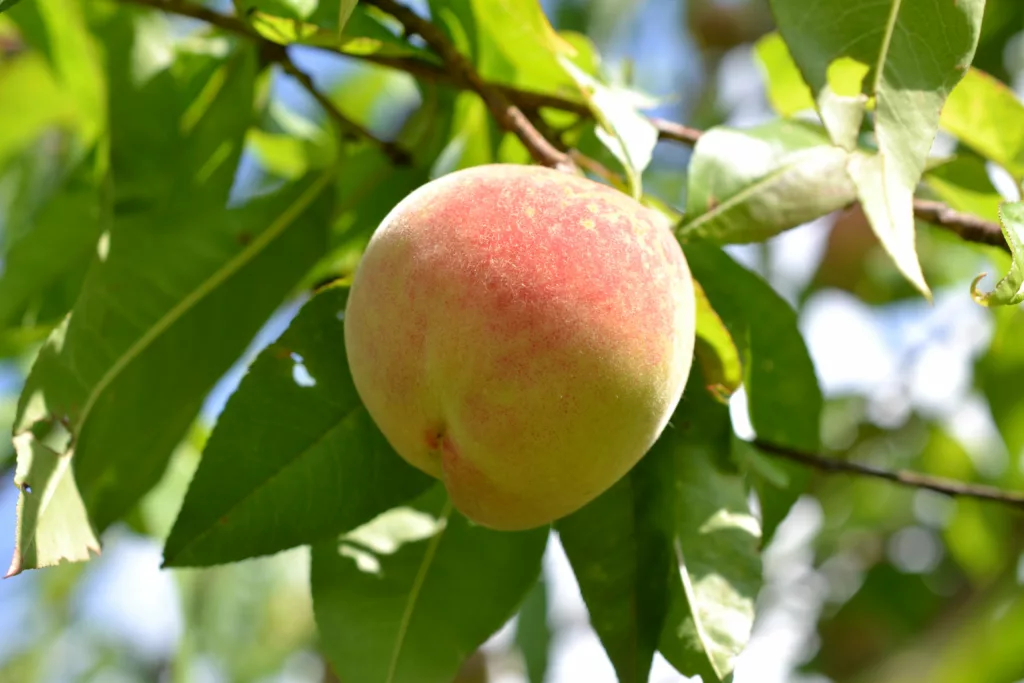
Bonanza and Harrow Diamond peach trees have been cultivated for shade tolerance. These varieties will perform better than others in a shady situation, but any peach tree can still do well in partial shade.
You’ll get peaches from your trees in an area with dappled shade with 4-6 hours of direct sun. Without dappled shade, a minimum of 6 hours of sun is best.
Zones 6-8 are ideal for peach trees, but they are successfully grown in zones down to 4 and up to 10.
Our peach trees are situated under a mix of 80-foot-tall hardwood trees. They get partial sun and dappled light through the hottest part of the day. We don’t have shade-tolerant varieties and plan to open up the canopy for more fruit.
Pear (Pyrus)
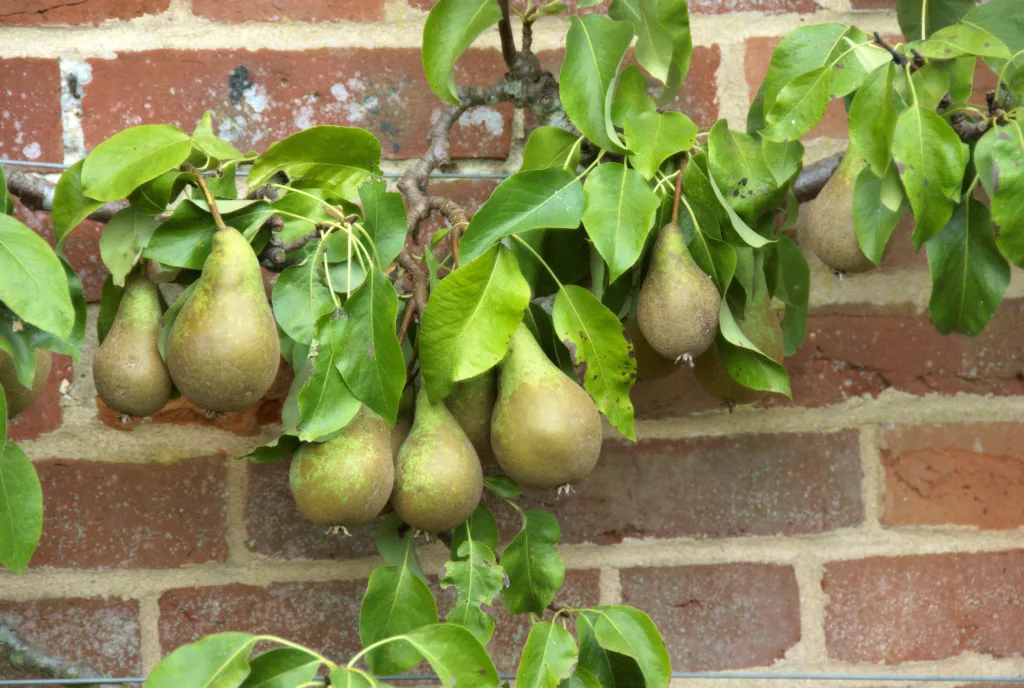
Pears are generally known to grow well without full sun. Some varieties do better with shade than others, and for the most appropriate tree, you’ll be glad to know shade-tolerant varieties.
The best pear tree varieties to grow in a shady spot are Bartlett, Anjou, or Moonglow. You’ll have better success with these varieties and thankfully, Bartlett, a very popular and enjoyed pear, is one that seems to fruit the best in shade!
Other varieties will still grow and fruit in shade, but won’t perform better than those three options.
Fruit production on pear trees, in general, will be lower in shade than when planted in full sun. A brief 4-6 hours of direct sun is enough to grow and yield good fruit. Ideally, the rest of the day is bright-shade rather than dark-shade.
Like other fruit trees in the shade, vegetative growth will be slower and appear more spread out. Fruit production may also happen a little later than trees positioned in full sun as growth is not only slightly slower but warming up from winter also takes a bit longer in shade.
For the best success:
- plant your fruit tree in the sunniest spot available
- keep it pruned for optimal light penetration
- Adjust watering and general care appropriately with the given environment (For example: avoid watering it the same as full sun fruit trees)
Loquat (Eriobotrya japonica)
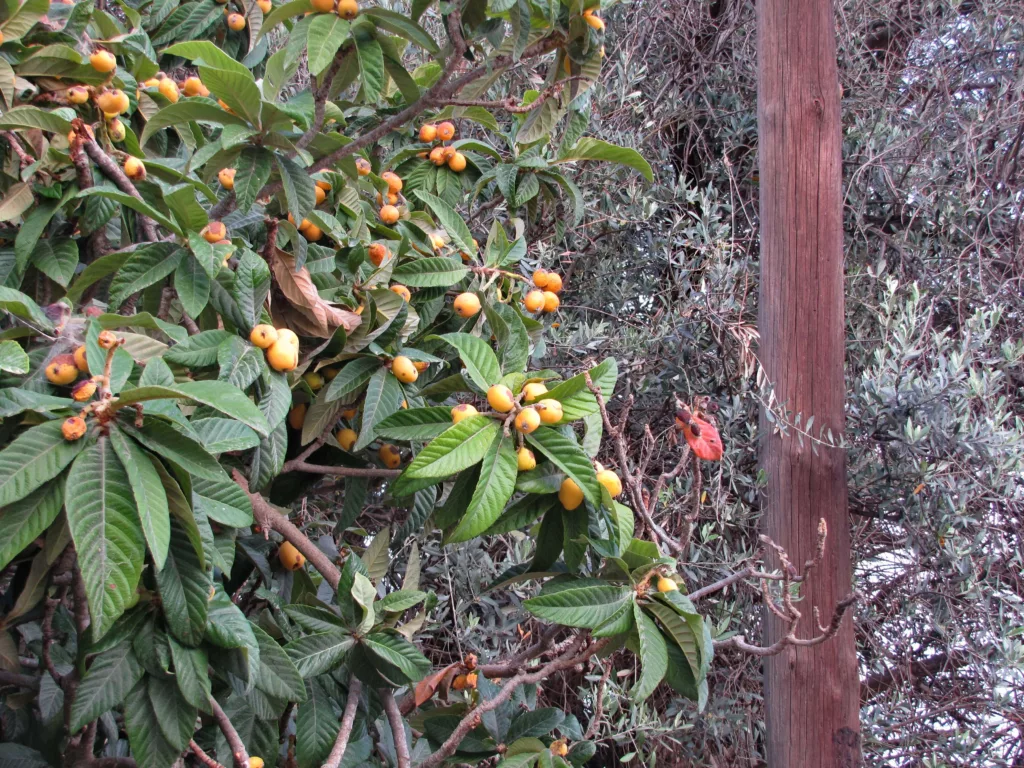
Selecting shade-tolerant varieties of loquat trees will result in the best success growing them in partial shade.
The best loquat varieties for shade are Oliver, Gold Nugget, Champagne, and Victory. When choosing between these four, your local nursery or loquat growers will be able to advise you on the best shade-tolerant option for your area.
Other varieties that aren’t known to be as shade tolerant will grow and produce less fruit.
Some growers have reported copious crops from loquats in moderately full shade, but they were large very established trees.
Loquat fruits have a sweet floral taste with a blend of cherry, plum, and apricot. The fruit can be used to make cocktails, custards, cakes, salsas, margaritas, chutneys, smoothies, sauces, or simply enjoyed raw!
Seedlings are offered on Etsy.
Fig (Ficus carica)
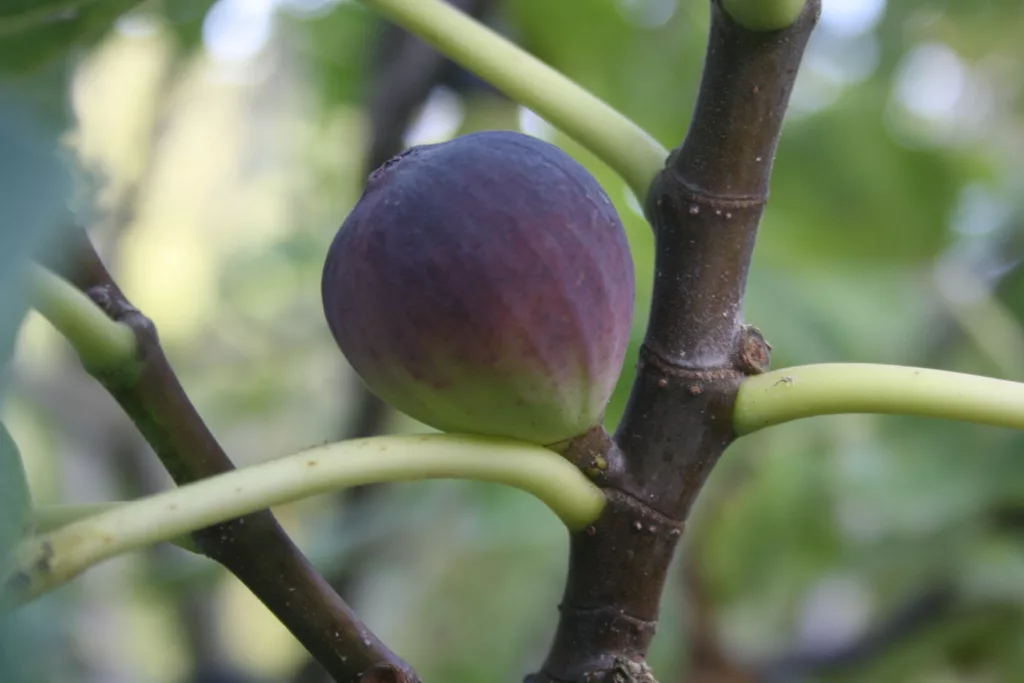
Figs are an excellent choice for shadier spots. Their smaller fruits don’t demand a lot of energy to produce and are generally quite adaptable. Some figs are more adaptable than others.
The best varieties for planting in partial shade include Black Jack, Black Mission, and Petite Negra. You’ll likely have success with any variety recommended for your area, but for shade, these are the best picks.
It’s been reported that fruit from shade-grown figs are less flavorful. So if you can position your tree to have at least 4-6 hours of direct sun, you’ll likely still end up with high-quality fruit.
Anne, a Florida friend, has a fig on the north side of her garage, “it only gets a couple of hours of direct sunshine, but lots of fruit ripens.”
If growing good fruit in partial shade is your priority, fig trees are a great option.
Seedlings are offered on Etsy.
Guava (Psidium guajava)
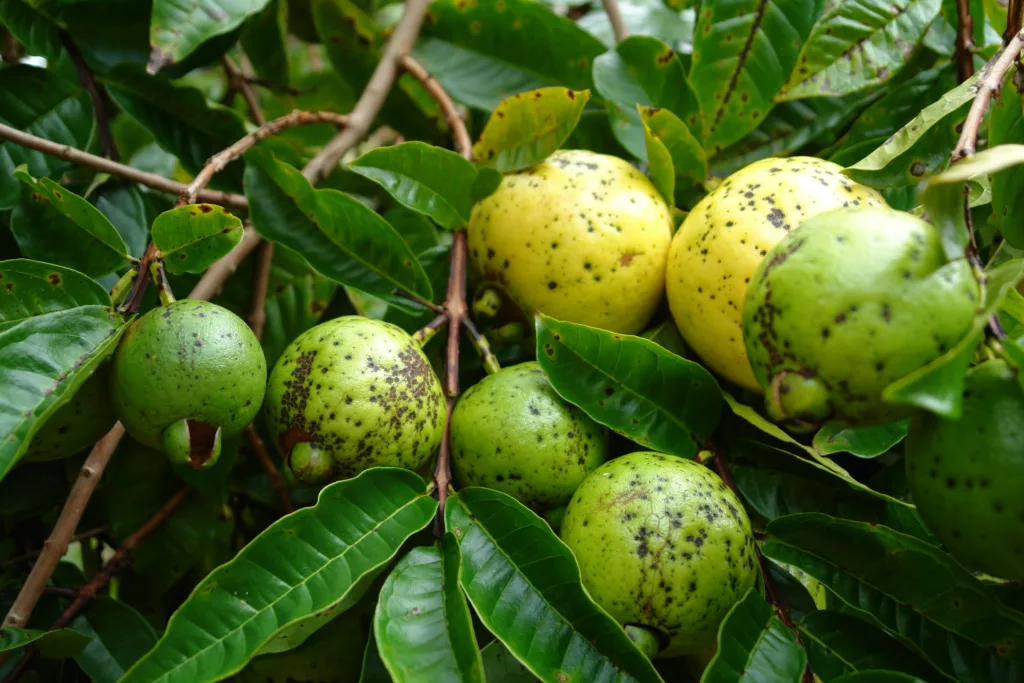
Guavas are often grown ornamentally and to provide shade to other pretty plants. If you’re looking to fill a partially shaded spot with fruit, guava is a beautiful (and tasty) choice.
In general, guavas are known as a “shade tolerant invasive species.” When in full shade they may not fruit much if at all, but they’ll still grow vegetation.
In partial shade, however, many growers report good fruit from guavas. Even though it’s less than when in full sun, you’ll still get a good harvest of ripe fruit.
For good fruit in shade, the best varieties of guava to look for are Tropic Pink, Mexican Cream, Ruby Supreme or Red Malaysian. These varieties are known best for adaptability to various conditions including shade.
For best fruiting success, provide a minimum of 6 hours of direct sun a day. Eight hours is better, but six can work.
Guava is a special fruit to grow at home because stores only sell their fruit when green! When purchased the way, they go bad easily on the counter as you wait for them to ripen.
Fresh-picked tree-ripened guavas, however, don’t go bad so easily. When ripening on the tree, they are still fueled with life and will only go bad if truly over-ripe.
Guava is described to taste like a cross between a strawberry and a pear. Use fruit to make sweet or savory dishes.
Lime (Citrus × latifolia)

Lime trees produce small citrus fruit and According to Horticulture: Plants for People and Places, Volume 1 pp 159–195, citrus trees, in general, are quite shade tolerant. While any citrus tree won’t reach its full potential in partial shade, you’ll still have a healthy tree and good fruit.
The best lime trees for shade are Tahiti, Kaffir, and Rangpur. Tahiti limes are known for being adaptable and productive in unideal conditions, including part-shade. For your typical lime fruit, Tahiti is your best pick.
Kaffir limes are often grown for the leaves, you’ll get great vegetation in the shade, and you’ll still get zesty fruit. Rangpur limes are actually a citrus hybrid of orange and lemon, so it isn’t really a lime, however, they are known to tolerate partial shade.
A minimum of 6 hours of direct sun is ideal for any citrus tree, but don’t worry, in sunny windows, many citrus trees even fruit indoors!
ExoticLandSeeds sells Tahiti lime seeds on Etsy.
Lemon (Citrus limon)
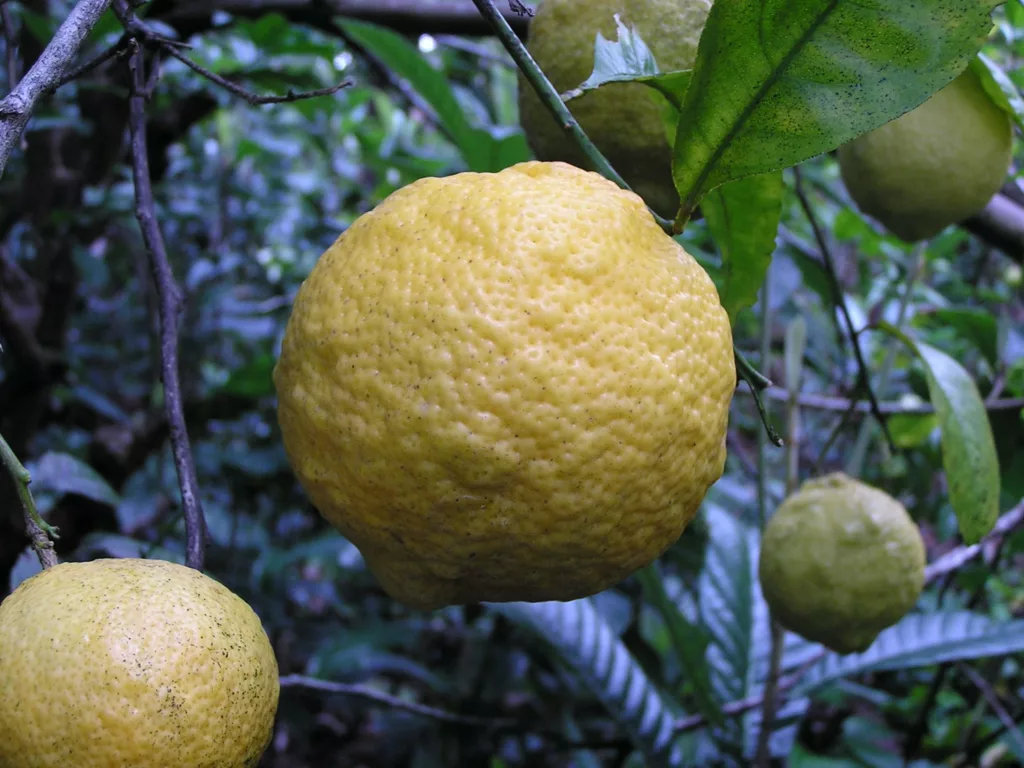
Lemons and other citrus thrive in subtropical climates. And where there is sun, there is shade. And in the shade, sometimes, could be lemon trees!
They fruit best in full sun but can grow and fruit well in partial shade, hence their ability to grow and fruit indoors. Specific types of lemon trees grow better in shade than other lemon tree cultivars.
Improved Meyer Lemon, Ponderosa Lemon, and Variegated Pink Lemon are a few types of lemon trees that do better in shade than others. Meyer lemon trees are the most popular indoor lemon tree since it’s easy to grow and fruits well even without a full day of direct sun.
Several citrus growers report good fruit in partial shade for various citrus trees and lemons generally do well with regular care.
Meyer Lemon trees are the original popular lemon for growing well in partial shade and for sweeter-acidic fruits that grow to medium size.
The trees are compact with dark glossy leaves and reach up to 15 feet tall. Full sun is ideal, but a minimum of 4 hours of sun will still yield good fruit.
If planting in partial shade, give the tree an ideal soil pH (5.5-6.5), protect it from frost, and place in well-draining soil.
Improved Meyer Lemon trees are more resilient toward disease and adapt easier to various conditions, including partial shade.
Ponderosa Lemon trees are known for bigger fruit that can become grapefruit-sized. These large lemons are very acidic, so a little goes a long way.
Beware of thorns when pruning or harvesting.
These trees grow up to 12 feet. With greater cold tolerance, you’ll only need to protect ponderosa lemons from severe frosts.
Plants in well-drained soils for optimal performance, but rest assured, they are adaptable to other conditions. A minimum of 6 hours is best.
Variegated Pink lemon trees have foliage that’s actually variegated with yellow and green! Their medium-sized fruit flesh, however, is pink and acidic.
These lemons are more sensitive to cold temperatures, so protect them from frosts and cold winds. They’ve proven to be adaptable to partial shade. a minimum of 4 hours can work but 6 hours is better.
They will reach a 10-foot height and prefer well-drained slightly acidic soils.
Persimmon (Diospyros virginiana)
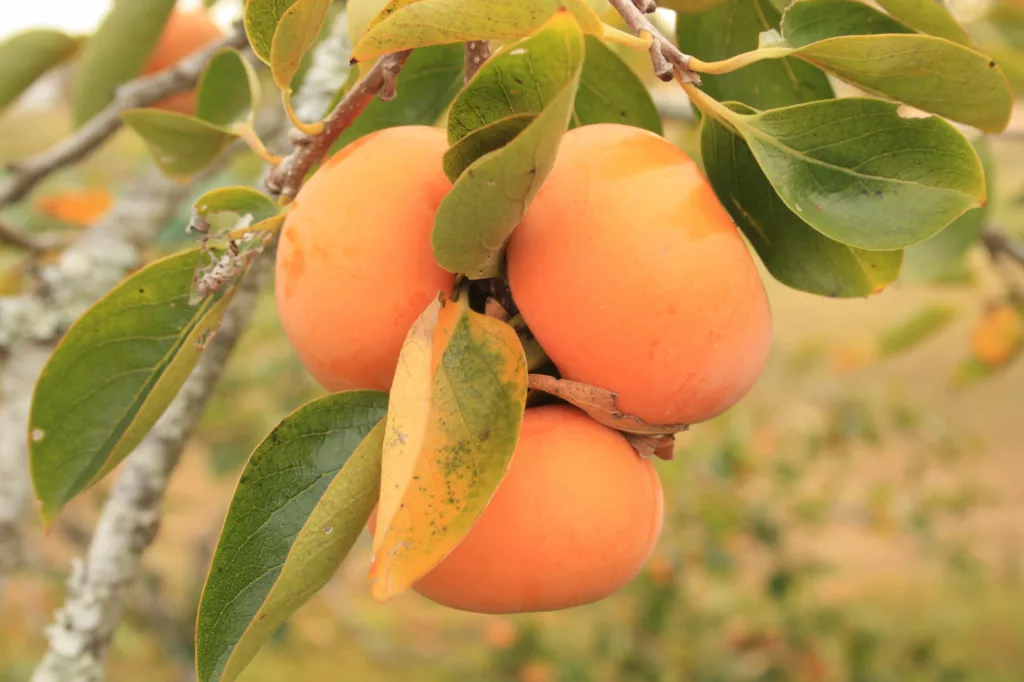
The first and best way to get good fruit from persimmons in the shade is to choose the best variety. Some varieties do better in shade than others.
Yates, Early Golden, and Prok persimmons are the best choice for partial shade positions. These cultivars are known for producing well in shade with as little as 4 hours of direct sun. Dappled sun throughout the day is better than deep shade.
To increase fruit production in the shade, keep your persimmon tree pruned with an open canopy.
Zones 4-8 are ideal for persimmons but can grow well in zone 9 too, and in a shady spot, may be better off in less intense heat.
Your local nurseries may offer better persimmons varieties to grow for zone 9 as they would be adapted to require fewer chilling hours. Chilling hours are required for breaking dormancy, leafing out, and ultimately setting good fruit. In general, you need 100-200 chilling hours (time at or below 32 degrees) for a persimmon tree.
Recent Posts
There’s no shortage of full-sun ground covers for zone 4 climates! Each plant in this list can withstand the frigid temperatures and also enjoy the hot sun in summer. Full sun means that a plant...
There's no shortage of full sun ground covers, not even in zone 3! Zone 3 climates offer hot but short-lived summers and very cold winters. So each plant in this list can withstand the frigid...
